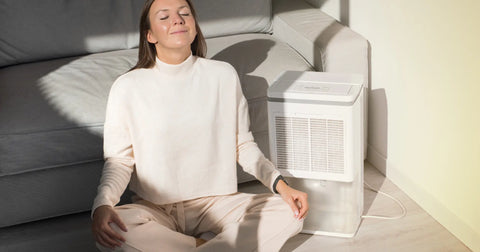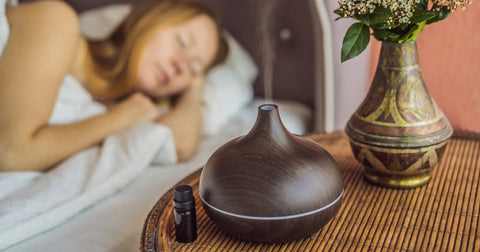Your Cart is Empty
- Shop
- About
- Learn
- Free Domestic Shipping Over $50
- +1(800)929-8935
- Login
- Free Domestic Shipping Over $50
- +1(800)929-8935

Finding the ideal sleeping conditions is key to a good night's rest, and one crucial factor often overlooked is the humidity level in your bedroom.
Humidity — the amount of water vapor in the air — plays a pivotal role in both sleep quality and overall health. Too much or too little can disrupt your sleep and exacerbate health issues.1
This article explores the best humidity level for sleeping, how it affects our body at night, and signs that your sleeping environment may be too humid. Understanding and optimizing the humidity levels in your bedroom could be your next step toward achieving perfect sleep hygiene.
During sleep, our bodies undergo a series of physiological changes, including fluctuations in body temperature and breathing rate, which can be influenced by the surrounding air quality. The right humidity level helps maintain these vital functions without disturbance.
High humidity levels can lead to excessive sweating and discomfort, while low humidity may dry out the mucous membranes in the airways, causing dry skin and respiratory infections.2
Environments conducive to dust mites or mold—often found in very humid or very dry conditions—can trigger allergy and asthma symptoms, disrupt sleep, and impact respiratory health.3
Ensuring the air isn't too moist or too dry can help minimize these issues, fostering a more conducive sleep environment.
Experts generally recommend maintaining indoor humidity levels between 40-60% for optimal sleep. This range helps ensure that the air is not too dry, which can irritate your respiratory system, or too humid, which can foster the growth of allergens like mold and dust mites.4
Within this ideal humidity level, your body can more easily regulate its temperature and facilitate critical processes like memory consolidation and slow-wave sleep, both essential for cognitive health and physical restoration.
Using tools like hygrometers to monitor the humidity, along with air conditioners or humidifiers to adjust it, can help maintain this balance, allowing your body to relax fully and rejuvenate overnight.

Recognizing the signs of high humidity in your sleep environment is crucial for taking corrective action. Here are key indicators that your bedroom might have excessive humidity levels:
Condensation on Windows: A clear sign of high indoor humidity is condensation forming on the inside of your windows. This happens when the warm, humid indoor air comes into contact with the cooler surface of the window glass.
Musty Odors: High humidity often causes a distinct musty smell, which indicates mold or mildew growth. These fungi thrive in moist environments and can quickly proliferate in your bedroom if humidity is not controlled.5
Visible Mold or Mildew: Besides smelling mold, seeing it around your bedroom—on walls, ceilings, or in corners—is a direct indicator of too much moisture in the air.5
Persistent Dampness: Bedding, curtains, or other fabrics in the room that feel damp to the touchare signs of excessive humidity. This not only creates an uncomfortable sleeping environment but can also damage materials and promote the growth of allergens.
Worsening Allergy and Asthma Symptoms: If you or your family members begin to experience increased allergy or asthma symptoms at night, it might be due to allergens like dust mites and mold spores that proliferate in high humidity.6
Sweating at Night: Waking up frequently because you feel hot and sweaty can be a result of too much humidity. Excess moisture in the air makes it harder for your body to regulate its temperature effectively.
Monitoring these signs and taking steps to adjust the humidity level can significantly improve your sleep quality and overall health. Tools like dehumidifiers or air conditioners with humidity control can be effective in maintaining an ideal sleeping environment.
Before adjusting your bedroom’s humidity, it's important to know the current levels. Using a hygrometer, an instrument that measures indoor humidity, can provide an accurate reading. These devices are available in digital forms as part of indoor weather stations or smart home systems.
Aim to check the humidity regularly, as indoor levels can fluctuate with changes in outdoor weather, indoor heating, and air conditioning use.
High indoor humidity can impact sleep quality and health. Here are some simple tricks to reduce excessive humidity:

Use a Dehumidifier: A dehumidifier removes moisture from the air, helping to maintain the recommended humidity levels for optimal sleep. Choose a size appropriate for your bedroom and adjust settings to keep humidity within the ideal 40-60% range.
Ventilation: To remove moisture, improve airflow in your bedroom by opening windows or using exhaust fans, particularly after showers or while cooking.
Air Conditioning: Air conditioners not only cool the air but also reduce humidity. Use your HVAC system to maintain comfort and air quality.
Moisture Absorbing Products: Silica gel or calcium chloride can absorb excess water vapor in small spaces and are handy in climates where humidity levels are persistently high.
Low humidity can cause discomfort and health issues such as dry skin and sore throats. Here are ways to add moisture to your air:
Use a Humidifier: Adding a humidifier to your bedroom can help maintain higher moisture levels, particularly in dry climates or when indoor heating is used. Ensure the humidifier is set to keep the room within the ideal humidity range.
Indoor Plants: Keeping plants in your bedroom can naturally add moisture to the air through the process of transpiration. Choose plants that require regular watering for better humidity control.
Leave the Bathroom Door Open While Showering: Allowing the steam from a hot shower to enter other parts of the home can help increase indoor humidity levels.
Boiling Water: Simply boiling water on the stove can increase humidity. This method can be especially useful in small apartments or homes.

To effectively use these devices for a good night's sleep, consider the following tips:
Position your humidifier or dehumidifier away from the bed. This prevents direct exposure to air that might be too moist or too dry and allows the device to distribute air more evenly throughout the room.
Regularly clean your device to prevent the buildup of mold and bacteria, which can be dispersed into the air. Follow manufacturer instructions for cleaning and replacing filters to ensure the unit operates effectively and safely.
Consider the noise level of the device to ensure it doesn't disrupt your sleep. Many modern humidifiers and dehumidifiers are designed to operate quietly, making them suitable for use in the bedroom.
By monitoring and adjusting your bedroom's humidity level, and ensuring your devices are well-maintained and correctly positioned, you can create the perfect environment for a restful night’s sleep. These adjustments not only enhance sleep quality but can also improve your overall health and well-being.
For those who prefer a more natural approach or wish to complement their gadgets, here are some DIY solutions to help balance your bedroom's humidity:
Bowls of Water: Placing bowls of water around your room can help increase humidity levels. As the water evaporates, it adds moisture to the air. This method can be particularly effective near heat sources like radiators or in dry climates.
Salt: To reduce humidity without the use of electric gadgets, try placing bowls of rock salt in different corners of your room. Salt naturally absorbs moisture from the air and can help maintain a more comfortable humidity level.
Damp Sponge: A damp sponge placed in a plastic bag with holes can serve as a portable humidifier. This can be especially handy in small spaces or when traveling.
Ventilation DIY: Simple home modifications, like improving ventilation with DIY air vents or using window treatments that allow for air flow while maintaining privacy, can effectively manage your indoor air quality and humidity.
These natural methods provide an eco-friendly and cost-effective way to manage your indoor environment, promoting better sleep quality and overall health.

The right humidity level is a game-changer for achieving quality sleep. It affects many aspects of your sleeping environment—from air quality and dust mite management to the comfort of your respiratory system.
Keeping bedroom humidity within the ideal range of 40-60% can significantly enhance sleep quality. It impacts everything from how quickly you fall asleep to your breathing rate and sleep cycles. High humidity can lead to excessive sweating and a disrupted sleep cycle, while low humidity can aggravate symptoms of dry skin, sore throat, and respiratory infections.
Experiment with the tips provided above to find the perfect balance for your unique bedroom environment. Whether you adjust your HVAC system, use a humidifier or dehumidifier, or employ natural methods like bowls of water or salt, finding the right setting can greatly improve your sleep quality and contribute to better health outcomes.
Perfect humidity is just one piece of the sleep puzzle. Mellodyn Sleep Easy works with your body's natural sleep-wake cycles to help you fall asleep faster and stay asleep longer—regardless of environmental conditions.
Wake up refreshed with Mellodyn.
What is the best temperature to complement the ideal humidity level for sleep?
The ideal temperature for sleeping is around 65 degrees Fahrenheit (18 degrees Celsius). This temperature, combined with the right humidity level, creates the perfect environment for sleep.
Can humidity levels impact sleep disorders?
Yes, inappropriate humidity levels can exacerbate breathing problems and disturb sleep, especially in individuals suffering from allergies, asthma, and other respiratory issues.
How often should I check and adjust my room's humidity?
It's wise to check your room's humidity regularly with a hygrometer. Adjustments might be needed with changing seasons, as indoor heating in winter and air conditioning in summer can significantly alter indoor humidity levels.
Are whole-home humidifiers a good solution for maintaining ideal humidity levels?
Whole-home humidifiers can be an effective solution for maintaining optimal humidity levels throughout your house, especially in regions with extreme seasonal variations in humidity.
Lappharat, S., Taneepanichskul, N., Reutrakul, S., & Chirakalwasan, N. (2018). Effects of Bedroom Environmental Conditions on the Severity of Obstructive Sleep Apnea. Journal of clinical sleep medicine : JCSM : official publication of the American Academy of Sleep Medicine, 14(4), 565–573. https://doi.org/10.5664/jcsm.7046
Okamoto-Mizuno, K., & Mizuno, K. (2012). Effects of thermal environment on sleep and circadian rhythm. Journal of physiological anthropology, 31(1), 14. https://doi.org/10.1186/1880-6805-31-14
Wolkoff P. (2018). Indoor air humidity, air quality, and health - An overview. International journal of hygiene and environmental health, 221(3), 376–390. https://doi.org/10.1016/j.ijheh.2018.01.015
Arundel, A. V., Sterling, E. M., Biggin, J. H., & Sterling, T. D. (1986). Indirect health effects of relative humidity in indoor environments. Environmental health perspectives, 65, 351–361. https://doi.org/10.1289/ehp.8665351
Seppänen O, Kurnitski J. Moisture control and ventilation. In: WHO Guidelines for Indoor Air Quality: Dampness and Mould. Geneva: World Health Organization; 2009. 3. Available from: https://www.ncbi.nlm.nih.gov/books/NBK143947/
Yonghua, S., Mehrabi Nasab, E., & Liuo, Y. (2022). Effect of Temperature and Humidity on the Allegro-inflammatory Factors and Allergic Rhinitis-related Behavior. Iranian journal of allergy, asthma, and immunology, 21(6), 704–710. https://doi.org/10.18502/ijaai.v21i6.11531